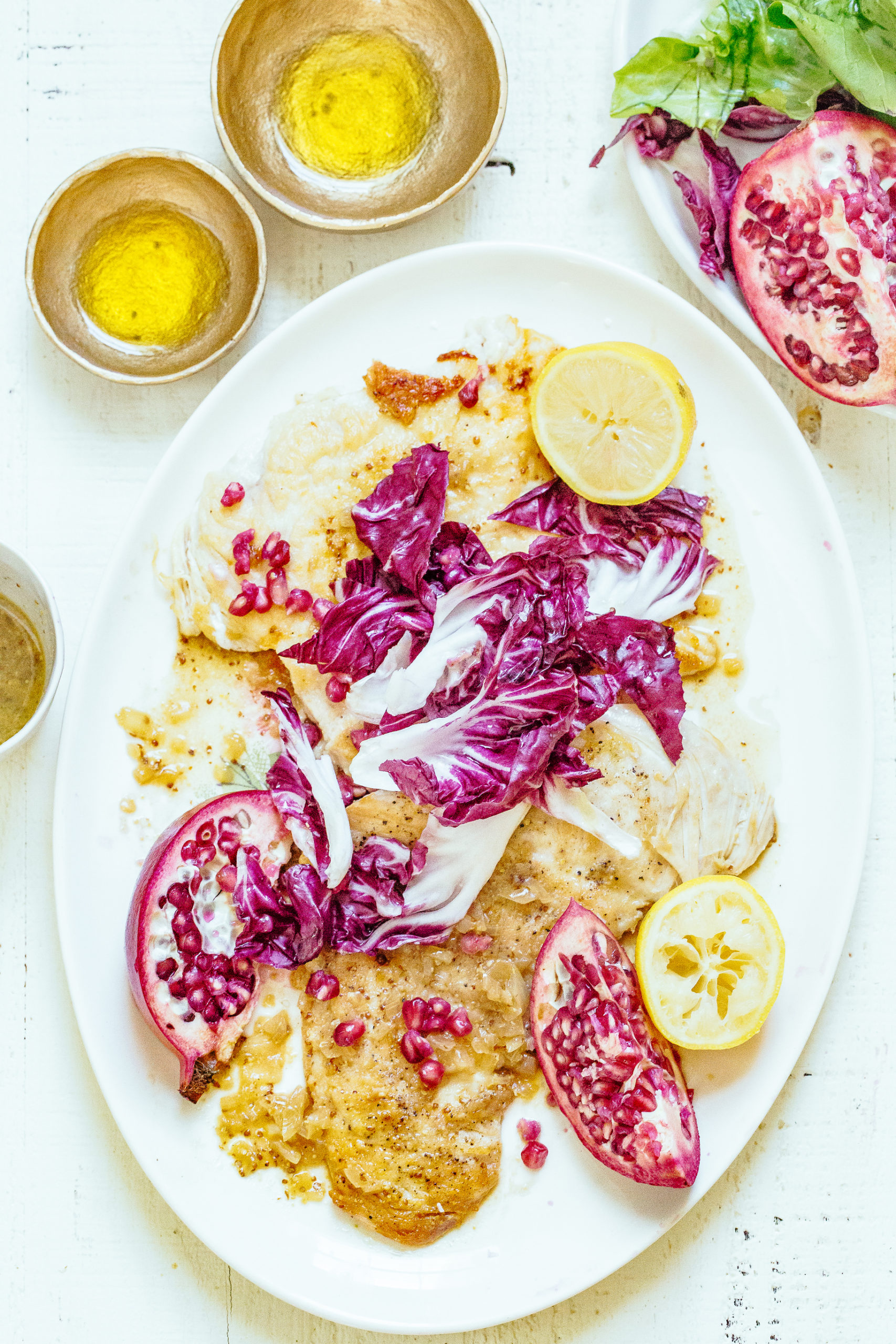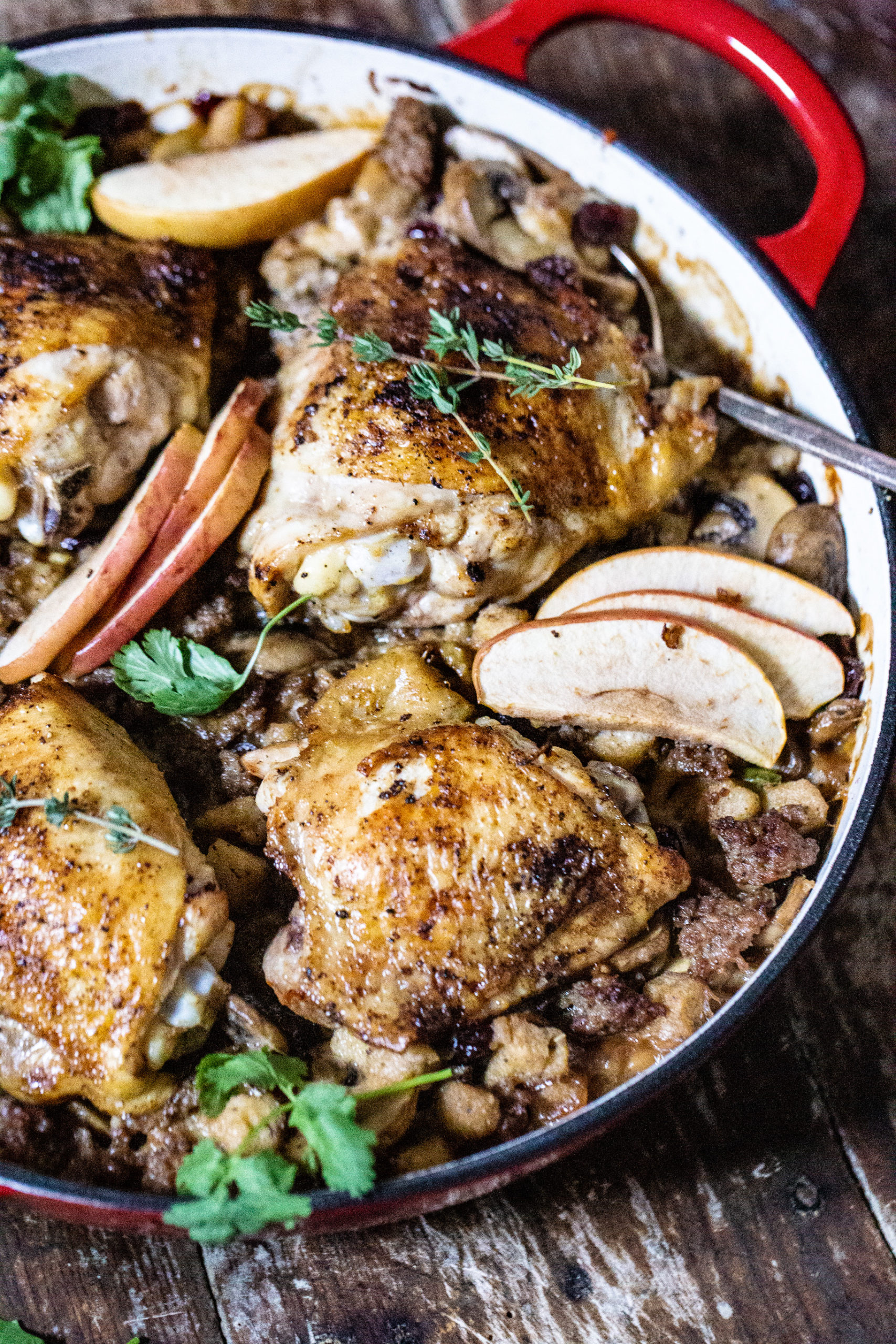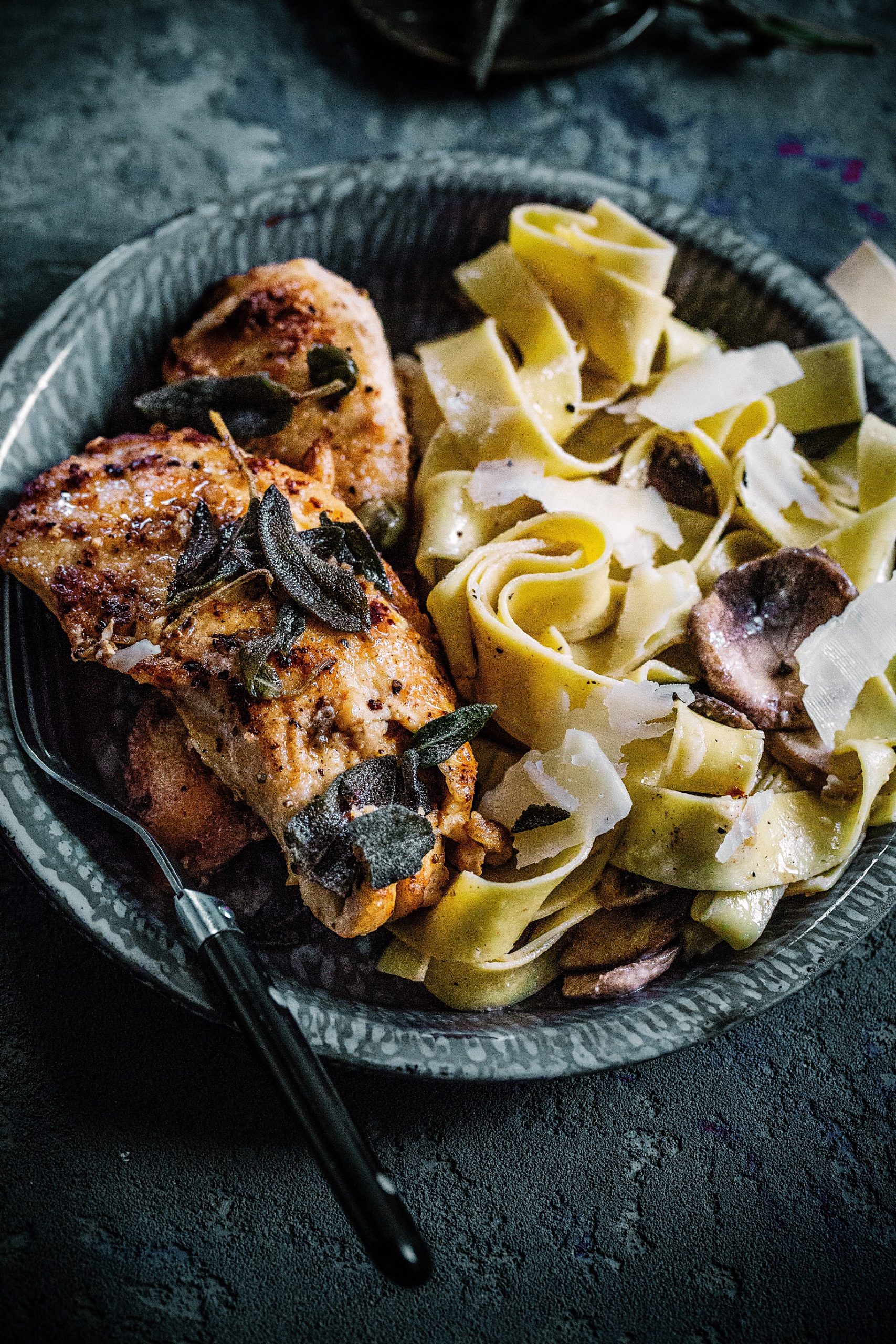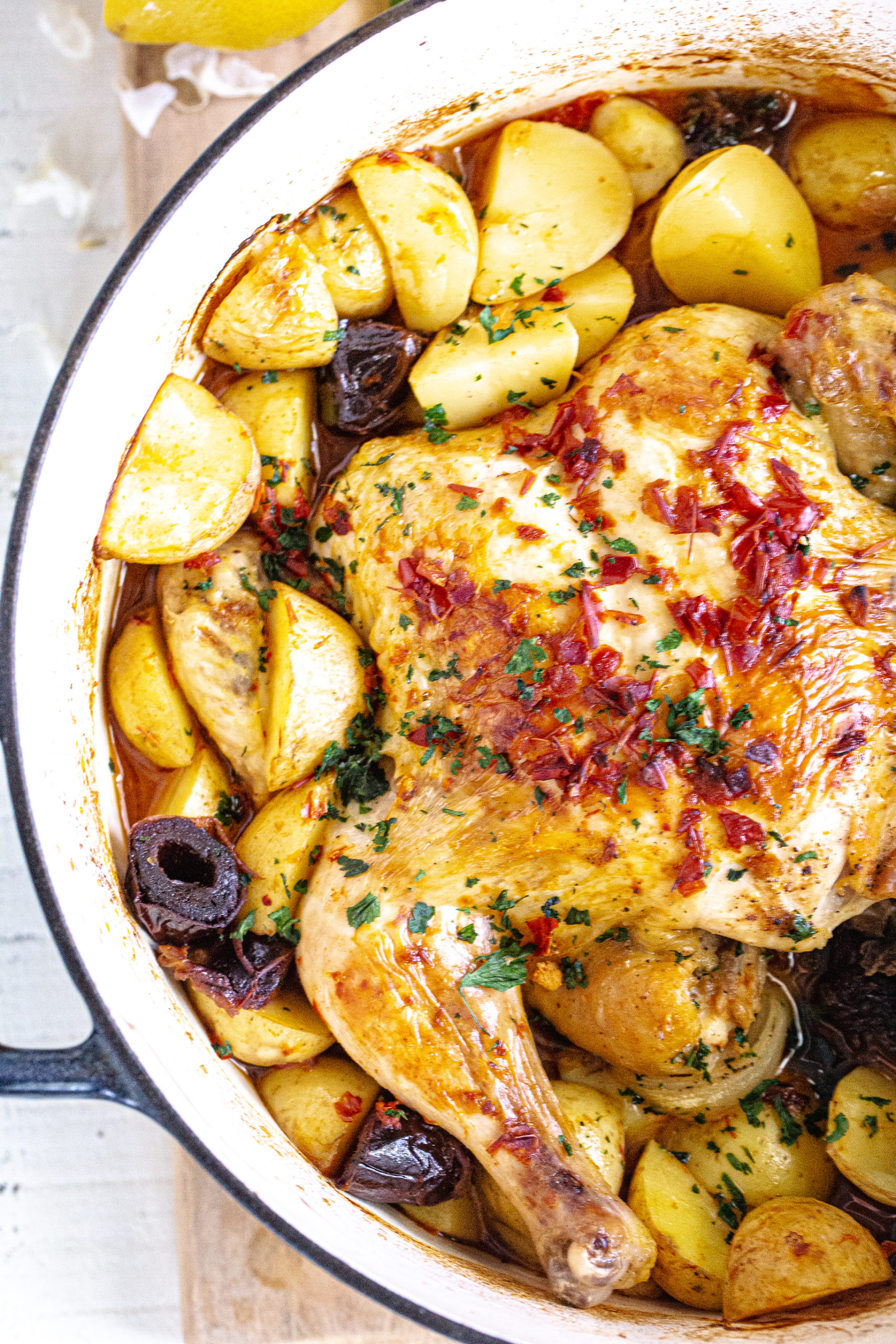Today, we’re digging into the classics again. I love exploring the halls of tried-and-true cooking by making recipes that have truly stood the test of time. The things that set the stage and held (still hold) court for so many iterations of recipes to follow. Enter this simple yet elegant Chicken Paillard. It really refers more to the actual method of preparation than anything else. So, I’m talking about what we do TO the chicken, as opposed to what we put ON the chicken. We’re dealing more in preparation today than in ingredients, really. Because Chicken Paillard by any other name, is simply pounded chicken …
Read on for lots more on this simply brilliant way to prepare chicken, or you can jump ahead to the main event.

What is Chicken Paillard?
Pronounced, “PIE – YARD” classic Chicken Paillard really refers more to a cut and treatment of meat than to any specific flavor profile. You’ll see chicken Paillard served with different sauces, toppings, and spices, but the thing that is consistent each time is the way that the chicken is sliced or cut and then pounded. Typically, a boneless skinless chicken breast is butterflied, or sliced crossways almost all the way through so the breast opens up like a book. Resembling something of a heart shape, this butterflied chicken breast is then pounded gently to further flatten and thin out the meat.
Why do you pound chicken?
Okay so, this may be my first dedicated post specifically to the wonder-fare that is Chicken Paillard, but actually – I’ve implemented the method several times on this site. I ask you to do it in my Lemon Butter Chicken with Herbs and my Creamy Dill Chicken. We do it in Cheesy Chicken with Balsamic Tomato Sauce as well. This pounding out of chicken is such a simply effective way to garner greater moisture and tenderness from (ahem, boring!) boneless, skinless meat that it’s hard for me to just not do it almost all of the time.
I’m typically a dark meat gal myself, preferring the chicken thigh over the breast any day of the week. That is, unless we’re giving the breasts the ole’ Paillard treatment. This changes the game and really levels the playing field between the dark and white cuts. Whereas dark meat – like the thighs and legs – is juicier and all-around more succulent than it’s white counterparts, there exists a shining ray of hope for all the white meat out there, and that’s what we’re talking about today (psst! It’s the pounding, y’all).
The Paillard method, explained
By simply placing your butterflied chicken breast on a flat work surface, covering it loosely with plastic wrap, and then giving it a swift and intentional thwacking with our rolling pin (or pint glass, your balled up fist, etc.), we’ll do several things almost without even realizing it:
- We will increase the surface area of the meat, which will result in lots more browned, crunchy bits to enjoy (flavor!).
- We will tenderize the meat which, when you’re dealing in boneless, skinless breasts, is a very crucial step to help make this chicken be all that it can be.
- The fact that you’re going to be cooking a much thinner piece of meat, means that you will also enjoy a shorter cook time. Thinner meat doesn’t need to cook nearly as long as hefty, honking, thick-as-can-be pieces. Nothing not to love about this.
- You will essentially create a very even, flat surface for the chicken by pounding it all out before you cook it. This not only helps with everything I’ve listed above, but quite frankly, it also contributes to a very aesthetically pleasing dish in the end – clean, smooth, well-browned meat that is the perfect canvas for one killer pan sauce (more on this in a sec!).

Where did Chicken Paillard originate?
Apparently, there was a restaurant owner in Paris, in the late 1800s, by the name of Paillard. He pounded his veal cutlets thin before cooking them, a preparation that became very popular. It is said that the technique was named after him.
“Paillard: This is more nearly a minute steak in terms of cooking time. It is… pounded thin enough to cook in a trice – merely browned quickly on each side. A paillard can be delicious and is especially suitable for those with dietary problems. Like the minute steak, it is best served plain.”
James Beard
Can you “Paillard” any other types of meat?
Yes! Absolutely. In fact, two posts back, I shared a recipe for Sicilian style steaks that I ask you to pound thinner before you go searing them off. I ask you to do this for basically the same reason – for the tenderizing, mostly. I’ve seen recipes for salmon paillard, where the fish is sliced very thin, rendering any extra pounding essentially unnecessary. Veal paillard is a relatively common preparation, as is pork paillard.
So again, it’s much more about the method today than anything else. If you can pound it thinner, then you can Paillard, as these ideas are one in the same.


What You’ll Need to Make this Classic Chicken Paillard
This recipe is for a simple pan-seared chicken cutlet, topped with a gorgeous, buttery pan sauce and a basic-yet-perfect salad of peppery radicchio. This delightfully bitter chicory needs nothing more than a gilding drizzle of great olive oil and a squeeze of lemon.
INGREDIENTS
2 boneless/skinless chicken breasts, halved crosswise and pounded thin
Regular olive oil, for cooking
Salt and pepper, to taste
2 shallots, minced
1/4 cup sherry (optional)
1 cup chicken stock
Juice of 1/2 lemon, plus more for dressing
1 tablespoon Dijon
2 – 3 tablespoons butter
10 – 12 radicchio and/or escarole leaves
Pomegranate seeds, to garnish
Extra Virgin Olive Oil, for drizzling


How to make it
This method is timeless, tested, tried, and true. There’s nothing going on in this recipe that is superfluous – it all serves a purpose. The pounding of the chicken stretches the meat further, while also tenderizing it greatly. The brown fond and drippings from the cooked chicken will serve to flavor the pan sauce, right from the get-go. A few simple ingredients come together to make a hugely flavorful pan sauce that perfectly blankets the browned chicken.
Lastly, we’ll just pile some peppery, punchy radicchio on top and dress it with some nice olive oil and a squeeze of lemon. The optional (yet recommended) element of sweet, crunchy pomegranate arils is my little extra touch. I always like the balance of sweet and savory on a plate, and if you can get them when they’re in season, pomegranate seeds are such a great way to do that. Plus, THAT CRUNCH!
DIRECTIONS
- Season the chicken breasts generously on both sides with salt and pepper. Add about a tablespoon of regular olive oil to a large skillet set over medium high heat. Cook the pound of chicken breasts until deeply browned on both sides, about four minutes per side. Transfer to a platter and hold in a warm oven (170 degrees) until ready to serve.
- 2. Reduce the heat to medium and add the shallots to the pan with the chicken drippings. Sauté for 2 minutes and then add the sherry, if using. Cook for about 1 minute more. Add the stock, lemon juice, Dijon, and season lightly with salt and pepper to taste. Simmer for about 5 minutes until slightly reduced; turn off the heat. Add the butter and stir to melt it in.
- 3. TO SERVE: Pour the pan sauce over the cooked chicken breasts on the plate. Top with some radicchio, and dress that with an additional squeeze of lemon and a generous drizzle of extra-virgin olive oil. Garnish with pomegranate seeds and enjoy.


If you like the looks of this easy Chicken Paillard, you might also want to try:
Sage Brown Butter Chicken Piccatta
PrintChicken Paillard (with Shallot-Mustard Pan Sauce)
- Yield: Serves 4
Ingredients
- 2 boneless/skinless chicken breasts, halved crosswise and pounded thin
- Regular olive oil, for cooking
- Salt and pepper, to taste
- 2 shallots, minced
- 1/4 cup sherry (optional)
- 1 cup chicken stock
- Juice of 1 lemon
- 1 tablespoon Dijon
- 2 – 3 tablespoons butter
- 10 – 12 radicchio and/or escarole leaves
- Pomegranate seeds, to garnish (optional)
- Extra Virgin Olive Oil, for drizzling
Instructions
- Season the chicken breasts generously on both sides with salt and pepper. Add about a tablespoon of regular olive oil to a large skillet set over medium high heat. Cook the pound of chicken breasts until deeply browned on both sides, about four minutes per side. Transfer to a platter and hold in a warm oven (170 degrees) until ready to serve.
- Reduce the heat to medium and add the shallots to the pan with the chicken drippings. Sauté for 2 minutes and then add the sherry, if using. Cook for about 1 minute more. Add the stock, juice of 1/2 lemon, the Dijon, and season lightly with salt and pepper to taste. Simmer for about 5 minutes until slightly reduced; turn off the heat. Add the butter and stir to melt it in.
- TO SERVE: Pour the pan sauce over the cooked chicken breasts on the plate. Top with some radicchio, and dress that with an additional squeeze of lemon, some salt and pepper, and a generous drizzle of extra-virgin olive oil. Garnish with pomegranate seeds and enjoy.
Keywords: Classic Chicken Paillard




